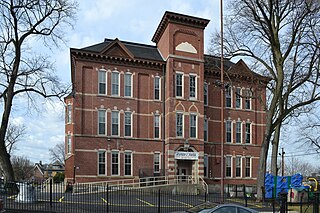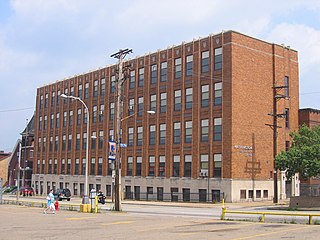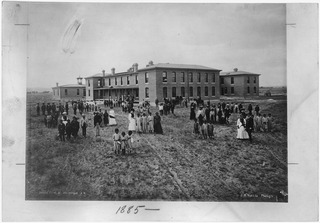
West Philadelphia High School is a secondary school located in the West Philadelphia section of Philadelphia, Pennsylvania at the intersection of 49th Street and Chestnut Street.

The Allegheny Arsenal, established in 1814, was an important supply and manufacturing center for the Union Army during the American Civil War, and the site of the single largest civilian disaster during the war. It was located in the community of Lawrenceville, Pennsylvania, which was annexed by the city of Pittsburgh in 1868.

The Robbins School, originally called Franklin School, is located at 4302 South 39th Avenue in South Omaha, Nebraska, United States. It was built in 1910 to serve a newly established and growing Polish community in south Omaha. A 2000 rehabilitation converted the former school to rental residential use.

The Lawrenceville School is a coeducational preparatory school for boarding and day students located in the Lawrenceville section of Lawrence Township, in Mercer County, in the U.S. state of New Jersey. Lawrenceville is a member of the Eight Schools Association and the Ten Schools Admissions Organization.

The Arsenal School is a historic school building in the Lower Lawrenceville neighborhood of Pittsburgh, Pennsylvania. It houses both a middle school, Arsenal 6–8, and an elementary school, Arsenal PreK–5, operated by Pittsburgh Public Schools. The building originally opened in 1932 as a junior high school, with the elementary school addition completed in 1939. It stands on part of the former site of the Allegheny Arsenal.

The Bayard School in the Lawrenceville neighborhood of Pittsburgh, Pennsylvania is a building from 1874 and is one of Pittsburgh's oldest surviving school buildings. The school was closed in 1939, along with the nearby Foster School and Lawrence School, when all students were transferred to the new elementary wing of Arsenal Junior High School. It was sold in 1941 and later used as a warehouse. It was listed on the National Register of Historic Places in 1986.

The Woolslair Elementary School in the Bloomfield neighborhood of Pittsburgh, Pennsylvania is a building from 1898. It was listed on the National Register of Historic Places in 1986.

The Stephen C. Foster School, also known as the Stephen C. Foster Community Center, is a historic school building in the Central Lawrenceville neighborhood of Pittsburgh, Pennsylvania. It is named for composer Stephen Foster, whose father William Barclay Foster once owned the land on which the building is located. The school opened in 1886 and operated until 1939, when its students were transferred to the new elementary wing of Arsenal Junior High School. Since 1939, the building has been used as a community center.

The Lawrence Public School, which is located in the Lawrenceville neighborhood of Pittsburgh, Pennsylvania, was built in 1872 and served as an elementary school, including instruction in the German language.

The McCleary Elementary School is located in the Upper Lawrenceville neighborhood of Pittsburgh, Pennsylvania, United States, and is a building from 1900.

The Samuel F. B. Morse School is located at 2418 Sarah Street in the South Side Flats neighborhood of Pittsburgh, Pennsylvania. Built in 1874, it was named in honor of Samuel Morse, commonly credited as the inventor of the telegraph.
Edward Emmett Dougherty, a.k.a. Edwin Dougherty was an architect in the southeastern United States. One of his best known designs was the Tennessee War Memorial Auditorium in Nashville in 1922. The work won state and national design competitions.

Washington Education Center is a former vocational school in the Pittsburgh neighborhood of Lawrenceville at 40th Street and Eden Way.

The Iowa Federation of Colored Women's Clubs (IFCWC) was an umbrella organization serving African-American women's clubs in Iowa. The motto of IFCWC was "Sowing Seeds of Kindness", and the organization was affiliated with the National Association of Colored Women. The club produced a journal called the Iowa Colored Woman. IFCWC sent delegates to represent the state at national conventions and opportunities such as "Colored Women's day" at the 1939 New York World's Fair. The IFCWC is also known for creating a black women's dormitory for the University of Iowa before the school was fully integrated. The building has been listed on the National Register of Historic Places.

St. Augustine Church is a historic Roman Catholic church in the Lawrenceville neighborhood of Pittsburgh, Pennsylvania. It has remained in use as a parish church since construction, currently serving Saint Pio of Pietrelcina Parish, which with St. Maria Goretti forms the Bloomfield/Garfield/Lawrenceville Grouping within the Diocese of Pittsburgh. The church has been operated by the Capuchin Friars since 1873 and is the headquarters of the Capuchin Province of St. Augustine.

Butler Street is a street in Pittsburgh, Pennsylvania which is the main commercial thoroughfare of the Lawrenceville neighborhood. Since the early 2000s, it has become a center for arts, dining, and music, with many local businesses including bars, restaurants, breweries, and specialty shops. It is named for the city of Butler, Pennsylvania, whose namesake was Maj. Gen. Richard Butler of the Continental Army.

Holy Family Church is a historic former Roman Catholic church in the Lawrenceville neighborhood of Pittsburgh, Pennsylvania, and a contributing property in the Lawrenceville Historic District. The church was built in 1939–40 and was designed in the Romanesque Revival architectural style with modernist design principles.

The Lawrenceville Historic District is a U.S. historic district in Pittsburgh, Pennsylvania, which encompasses the majority of the Lawrenceville neighborhood. The historic district includes 3,217 contributing resources, many of which are rowhouses, commercial buildings, and former industrial properties built between the 1830s and early 20th century. The district was listed on the National Register of Historic Places in 2019.

The Fulk-Arkansas Democrat Building is a historic newspaper headquarters building at 613-615 Main Street in Little Rock, Arkansas. It was built in 1916 by the estate of Francis Fulk, a prominent local judge, and was designed by Charles L. Thompson. It was built on the foundation of a 1911 structure that was destroyed by fire before it was finished. It was occupied by the Arkansas Democrat newspaper from 1917 until 1930, when it moved to the YMCA–Democrat Building. The building is of architectural importance for its association with Thompson, and its surviving Classical Revival details.

Albuquerque Indian School (AIS) was a Native American boarding school in Albuquerque, New Mexico, which operated from 1881 to 1981. It was one of the oldest and largest off-reservation boarding schools in the United States. For most of its history it was run by the Bureau of Indian Affairs (BIA). Like other government boarding schools, AIS was modeled after the Carlisle Indian Industrial School, using strict military-style discipline to strip students of their native identity and assimilate them into white American culture. The curriculum focused on literacy and vocational skills, with field work components on farms or railroads for boys and as domestic help for girls. In the 1930s, as the philosophy around Indian education changed, the school shifted away from the military approach and offered more training in traditional crafts like pottery, weaving, and silversmithing.

























